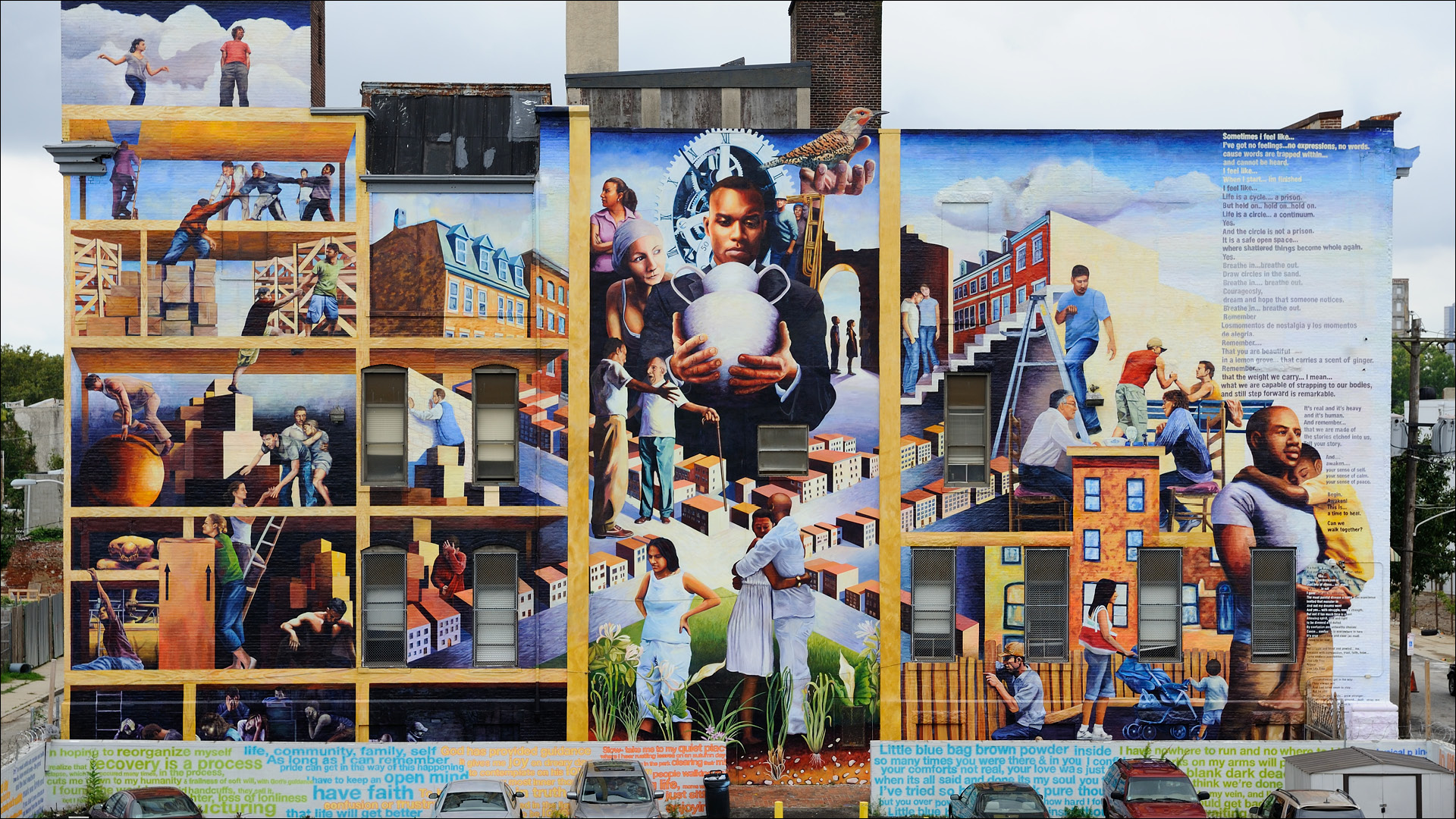Saudi Arabia’s AlUla is leaving no stone unturned, quite literally, in its efforts to conserve and restore millennia-old history and traditions, paving the way for a sustainable model of responsible tourism of epic proportions.
BY SHUVAJIT PAYNE AND KUNAL BHATIA

The lush landscape of AlUla’s oasis sits in green splendour against the desert’s sand-swept dunes.
Post the lockdown years, we had been eagerly scouting for destinations offering responsible travel. And our research led us to AlUla, a captivating oasis-city in the Medina province of Saudi Arabia, which was opened to archaeological exploration only in the 20th century and to international tourists very recently. On one hand, this serene, seemingly barren escape boasts a delicate desert ecosystem housing endangered wild species and prehistoric natural structures. On the other, it’s home to thousands of years of human history, having served as a capital city along the Incense Route for the ancient North Arabian and Nabataean kingdoms. Now, it’s rolling out a colossal and ambitious master plan for the development of premium tourism focused on sustainability. Since this promised to be spectacular, luxurious, and poignantly educational, we were hooked! And soon enough, we were flying over AlUla’s vast arid expanse stretching into the horizon, dotted with canyons, crimson cliffs, and enigmatic rock formations—all cast in mystical desert hues.
Our excitement knew no bounds as we landed at AlUla airport. Trained guides were to accompany us along our custom-tailored itinerary and engaging conversations with them at every turn transcended mere sightseeing. Because the city’s public transportation is still being developed, opting for a private tour (like ours), cab hire, or self-drive is ideal. And off we went, with a desire to know more about this mesmerisingly mysterious land.
THE BLISS OF GREEN
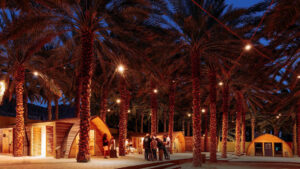
Palm trees surround the café at Daimumah.
A breezy half-hour drive along silky-smooth highways brought us to the surprisingly verdant, palm tree-covered heart of AlUla— Daimumah. This bustling, active piece of farmland has been curated with exhibits, art installations, quaint cafés, and canopied restaurants: an oasis within an oasis, if you like! The plantation is aptly named after the Arabic word for sustainability, and we soon discover why. After a sumptuous lunch, we wandered through shaded palm groves, fragrant botanical gardens, and open fields, stumbling upon informative interactive displays on the water conservation wizardry that has turned this desert patch into a green paradise. This included historic qanats (irrigation channels), sustainable farming practices, and old mud-brick housing. Experts revealed how these traditions now seamlessly blend with modern techniques.

Fresh meal of regional delights at Daimumah.
We observed how the cultivation ecosystem has three distinct layers here: towering date palms cast protective shadows over citrus trees, and nestled beneath their canopy are aromatic herbs basking in the dappled sunlight. Our guide proudly announced that, in AlUla, there are an astonishing 2.3 million date palm trees and 29 citrus varieties, ranging from sweet lemons to zesty kumquats. And all this cultivation is sustaining itself on a mere 0.2 inches of rainfall annually—how’s that for making every drop count?
ONE WITH THE EARTH

The trendy AlJadidah Arts District blends seamlessly within the ancient environs of the Old Town.
The impressive transformation of this agricultural haven amidst barren lands sparked a lively conversation with our guide about inclusive development. He was quick to highlight AlUla’s master plan that embraces sustainability on multiple fronts—from the preservation of history, nature, and culture, to community inclusion and the balanced integration of modernity.
We witnessed this in action as we headed to the nearby Old Town immediately after. Inhabited since the 12th century, it remained so till it was abandoned in the 1980s, with its residents moving to a new city nearby. Now, wandering through its narrow alleys flanked by more than 900 restored heritage buildings, we marvelled at the centuries-old houses, shops, town squares, and a distinctive fortress. Blending seamlessly with these historical treasures is the newly made vibrant creative hub called the AlJadidah Arts District. We were thrilled to see that AlUla’s charter for conservation has guaranteed that every restoration and new construction here is harmonious with the region’s architectural ethos, utilising locally sourced materials. It’s a promise that has been beautifully upheld here. The streets of this pedestrian-only artistic destination are buzzing with galleries, restaurants, and art stores, adorned with magnificent murals and wall art crafted with organic pigments. As the sun set, artists and performers take to the streets. The old and new structures are integrated together so well, we almost didn’t spot the new Dar Tantora, a boutique property blending in with the Old Town buildings. This hotel minimises artificial lights and cooling systems by lighting over a thousand candles each evening and using natural ventilation in place of air-conditioning, replicating a slice of medieval times! Beyond a unique authentic experience for its guests, we feel this could be the new benchmark in low-impact luxury travel, leading the way in frugal energy use.
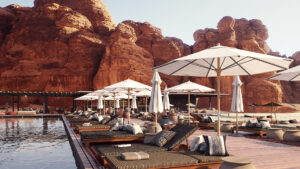
The naturally harmonious setting of the pool deck area at Our Habitas.
It was time to retreat to our own accommodation, Our Habitas, where we checked into a secluded luxurious villa amidst sandstone cliffs. Witnessing the resort’s minimally invasive build, an ethos also evident at the close by tented villas of the Banyan Tree Hotel, we realised the prevailing theme here was harmony with nature, ensuring equilibrium and proximity with the desert. At the Reception, we were inspired to see a line-up of daily activities that promoted health and healing: yoga, meditation, and breathwork, all set in the solitude of wind-swept rocks. Eager to experience these rejuvenating pastimes, we embarked on myriad desert activities like e-biking to interactive art; it really felt like we were spending time in an other-worldly paradise. Later, the on-site restaurant, Tama, served an oasis-to-table culinary experience, using locally sourced ingredients. Our night drew to a close as we lay on the sofa beds outside our villa, gazing at the gigantic moonlit cliffs bathed in the soothing sounds of meditative singing bowls, while our camera captured a breathtaking time-lapse of star trails!
RELIVING HERITAGE
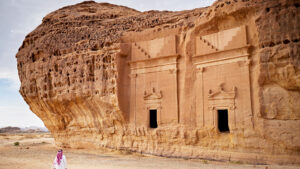
A visitor admires the ancient rock-cut architecture of Hegra.
The next day, we woke up early to satiate our inner history aficionado. Our first stops included two of the most significant excavated sites in the vicinity—Dadan and Hegra. In the ancient city of Dadan, imposing lion figures, skilfully chiselled into the rocks, overlook the remnants of this once-glorious capital. While Hegra, a city dating back 2,000 years to the Nabataean era, proudly holds the title of Saudi Arabia’s first UNESCO World Heritage Site.

Camels resting in front of the illuminated ancient tombs in Hegra create a magical vista.
With over 100 monumental tombs, most of which boast intricately carved façades, Hegra stands as a testament to the grandeur of its illustrious past. As the sun set, these tombs became the illuminated backdrop for a theatrical performance titled Hegra After Dark, whisking all our five senses back in time. Graceful actors narrated stories that made history come alive and pop-up markets recreated the hustle and bustle of a bazaar of yore.
We meandered through the market, stopping by carts to sample perfumes, apply organic kohl to our eyes, and savour snacks made of dates and dry fruits, all the while listening to the enchanting melodies of folk songs. For those few hours, the distant past became the present for us.

A large-scale art installation in the midst of AlUla’s desert sands.
On our third and final day, we decided to delve deeper into the petroglyphs and rock art of the region. A staggering 27,000 archaeological sites have been identified within AlUla in recent times. Among these, a concentration of rock art is found in Jabal Ikmah—a mountainous wonderland for history buffs like us. This landmark is peppered with sketches on stones left by settlers and travellers along the bygone trading passageway known as the Incense Route. It’s an ‘open-air library’ with a view! Our guide, a lady in an abaya and speaking impeccable English, decoded some of these engravings for us. She informed us that researchers continue to document and interpret the artworks, which are in several languages including Aramaic, Minaic, Dadanitic, Thamudic, Nabataean, and Safaitic. We were even taught how to distinguish Aramaic inscriptions from the others! The whole experience transcended mere spectatorship and, instead, made us feel like custodians of a precious heritage.
THE CHANGING TIMES
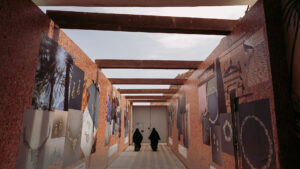
Local artwork lines an exhibit near the Madrasat Addeera.
An intriguing conversation ensued with the female guide on the changing role of women in the country as she emphasised how she now has the choice to adorn the abaya. And this dialogue on the rising participation of women in the workforce linked well to our next stop, the Madrasat Addeera. Housed in the building of AlUla’s first secondary school for girls, the learning centre is dedicated to nurturing traditional handicraft skills among local women. Given more time, we would surely have partaken in one of the walk-in workshops on a range of crafts, from stone carving and making colour dyes, to creating art inspired by local flora and fauna. The interactions here threw light on the critical community-centric perspective of any sustainability model. For instance, the Royal Commission for AlUla envisions the employment of over half of the population in arts, crafts, and hospitality.

A gazelle at AlUla’s Sharaan Nature Reserve.
All too soon, it was time to head back. During our three-hour journey to Tabuk city’s airport, our chats with our guide continued. We learned about the astounding feat of regeneration at AlUla’s Sharaan Nature Reserve, where over 1,580 animals from four endangered species have been reintroduced in just four years. Additionally, 27 Arabian leopard cubs are thriving in a protected environment, awaiting their roaring return to the wild. And, in AlUla’s bid to inch toward carbon neutrality, the world’s longest battery-powered tramway is under construction here, too. Meanwhile, on the cultural front, the newly unveiled Wadi AlFann, or ‘Valley of the Arts’, invites contemporary artists to unleash their creativity on the landscape with stunning super-scale art installations! It just goes to show, where there’s will, even flowers can bloom in a desert!
Related: 6 Ways To Enjoy Wonderful Waterfront Activities In Mauritius




